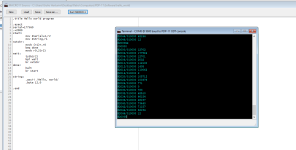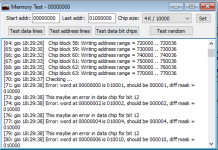RetroNewbie
Experienced Member
Hi everyone. I've wanted to play around with a PDP-11 so I bought various cards and pieces to assemble one.
Right now I have a basic system up and booting into microODT. The next step would be to try and boot RT-11 with a tu58 emulator but I've been having some problems.
All the type-in bootstraps that I've found online and on the tu58 manual dont work, when I type "1000G" they just halt indefinitely without sending anything on the TRX line of the SLU (checking with a scope).
I was thinking of an addressing or SLU problem but this is the result of some testing if it helps (typed in through microODT):
Test #1:
MOV #1,R1
MOV R1,@#17776504
> This successfully puts a "HIGH" signal on the SLU TRX line.
Test #2:
@17775405/000200
@17776506/... 1111111
> The transmit ready bit is set and I can sucessfully send some data into the TRX line.
Test #3 (compiled with macro11):
.ASECT
.=1000
MOV #0,R2
10$:
BIT #200,@#17776504
BEQ 10$
MOV #111111,R2
MOV R2,@#17776506
BR 10$
> No data is sent through the TRX line, or sometime sent once.
This is the setup (cards are in order of placement in the backplane):
- H9275 backplane
- M8192 Cpu card
- M8028 SLU (used for the tu58)
- M7940 (used for micro ODT console)
- M8059 Ram
Thank you in advance, I'm really at a loss.
Right now I have a basic system up and booting into microODT. The next step would be to try and boot RT-11 with a tu58 emulator but I've been having some problems.
All the type-in bootstraps that I've found online and on the tu58 manual dont work, when I type "1000G" they just halt indefinitely without sending anything on the TRX line of the SLU (checking with a scope).
I was thinking of an addressing or SLU problem but this is the result of some testing if it helps (typed in through microODT):
Test #1:
MOV #1,R1
MOV R1,@#17776504
> This successfully puts a "HIGH" signal on the SLU TRX line.
Test #2:
@17775405/000200
@17776506/... 1111111
> The transmit ready bit is set and I can sucessfully send some data into the TRX line.
Test #3 (compiled with macro11):
.ASECT
.=1000
MOV #0,R2
10$:
BIT #200,@#17776504
BEQ 10$
MOV #111111,R2
MOV R2,@#17776506
BR 10$
> No data is sent through the TRX line, or sometime sent once.
This is the setup (cards are in order of placement in the backplane):
- H9275 backplane
- M8192 Cpu card
- M8028 SLU (used for the tu58)
- M7940 (used for micro ODT console)
- M8059 Ram
Thank you in advance, I'm really at a loss.



